Knee Conditioning Program
Purpose of knee conditioning
This general knee conditioning program helps individuals return to sports and other recreational activities after an injury or surgery.
Always discuss any exercise conditioning program with a doctor or physical therapist to ensure the proper exercises are initiated for individual rehabilitation goals. The information is provided is more educational than instructional and not intended to serve as medical advice.
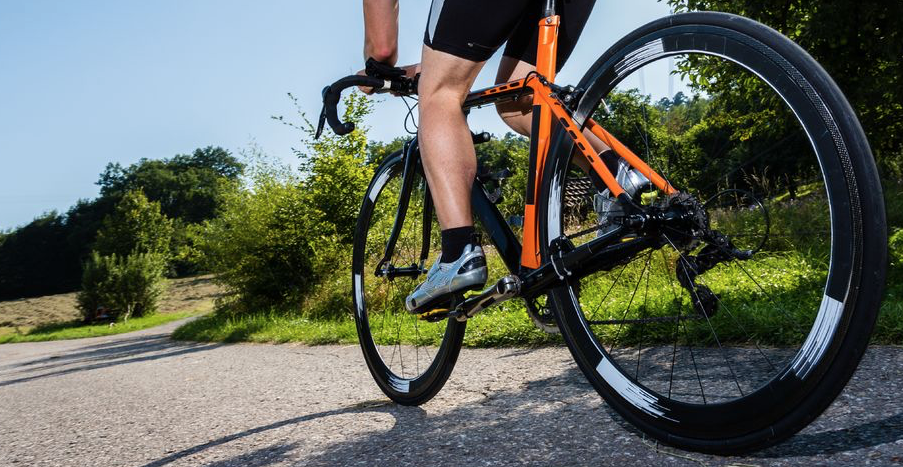
Strength & Flexibility
Exercises are designed to strengthen the muscles that support the knee to reduce the stress on the knee joint. Muscles strengthened must be stretched to restore range of motion and prevent injury. Gently stretching and strengthening exercises help reduce muscle soreness and keep your muscle long and flexible.
Muscles targeted in the knee conditioning program include:
-
Quadriceps (font thigh)
-
Hamstrings (back thigh)
-
Abductors (inner thigh)
-
Gluteus Medius and Gluteus Maximus (buttocks)
Length of program
The knee conditioning program typically continues for four (4) to six (6) weeks, unless specified by the doctor or physical therapist. Upon recovery, exercises can continue as a maintenance program for good health. Exercises are performed two (2) to three (3) days a week to restore strength and range of motion to the knees.
Let’s get started
Before every an exercise program, a five (5) to ten (10) minute warm-up helps get the heart pumping and limbers up your muscles (light walk or cycle on the stationary bike). Following the warm-up and after completing the exercise program, stretch out all the muscles.
Never ignore what the body tells us
Any pain experienced during physical exercise should not be ignored, consult the doctor or physical therapist to rule out any serious consequences to continuing the exercise program.
STRETCHING EXERCISES
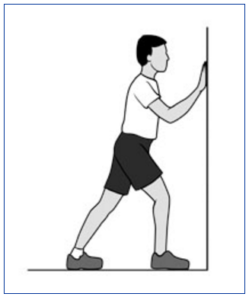
Heel Cord Stretch – two (2) to four (4) sets for six (6) to seven (7) days each week
Main muscles worked: Back of calf downward to heel
Steps
-
Stand facing the wall with the unaffected leg forward with a slight bend at the knee. The affected leg is straight and behind, with the heel flat and toes pointed in slightly.
-
Keep both heels flat on the floor and press hips forward toward the wall.
-
Hold the stretch for 30 seconds and then relax for 30 seconds. Repeat.
TIP: Do not arch back.
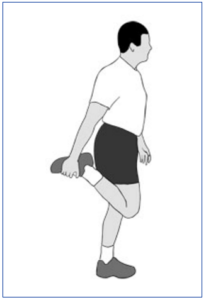
Standing Quadriceps Stretch – two (2) to three (3) sets for four (4) to five (5) days each week
Main muscles worked: Quadriceps
Steps
-
Hold the back of a chair or a wall for balance.
-
Bend your knee and bring your heel up toward you buttock.
-
Grasp you ankle with you hand and gently pull your heel closer to your body.
-
Hold this position for 340 to 60 seconds.
-
Repeat with opposite leg.
TIP: Do not arch or twist your back.
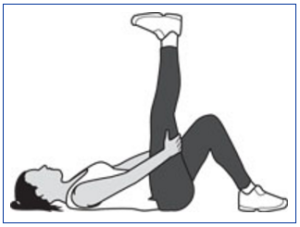
Supine Hamstring Stretch – two (2) to three (3) sets for four (4) to five (5) days each week
Main muscles worked: Hamstrings
Steps
-
Lie on the floor with both legs bent.
-
Lift one leg off of the floor and bring the knee toward your chest. Clasp your hands behind your thigh below your knee.
-
Straighten your leg and then pull it gently toward your head, until you feel a stretch. (If you have difficulty clasping your hands behind your leg, loop a towel around your thigh.
-
Grasp the ends of the towel and pull your leg toward you.)
-
Hold this position for 30 to 60 seconds.
-
Repeat with the opposite leg.
TIP: Do not put your hands at your knee joint and pull.
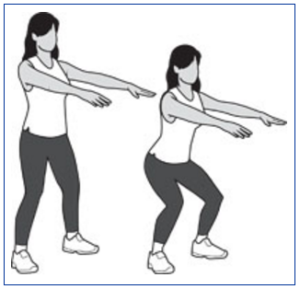
Half Squats — three (3) sets of ten (10) for four (4) to five (5) days each week
Main muscles worked: Quadriceps, gluteus, hamstrings
As the exercise becomes easier to perform, gradually increase resistance by holding hand weights. Begin with 5 lb. weights and gradually progress to a greater level of resistance, up to 10 lb. weights.
Steps
-
Stand with your feet shoulder distance apart. Your hands can rest on the front of your thighs or reach in front of you. If needed, hold on to the back of a chair or wall for balance.
-
Keep your chest lifted and slowly lower your hips about 10 inches, as if you are sitting down into a chair.
-
Plant your weight in your heels and hold the squat for 5 seconds.
-
Push through your heels and bring your body back up to standing.
TIP: Do not bend forward at your waist.
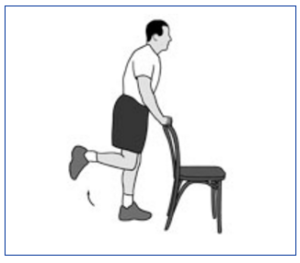
Hamstring Curls — three (3) sets of ten (10) for four (4) to five (5) days each week
Main muscles worked: Hamstrings
Equipment needed: As the exercise becomes easier to perform, gradually increase the resistance by adding an ankle weight. Begin with a 5 lb. weight and gradually progress to a greater level of resistance, up to a 10 lb. weight.
This exercise can also be performed on a weight machine at a fitness center.
Steps
-
Hold onto the back of a chair or a wall for balance.
-
Bend your affected knee and raise your heel toward the ceiling as far as possible without pain.
-
Hold this position for 5 seconds and then relax. Repeat.
TIP: Flex your foot and keep your knees close together.
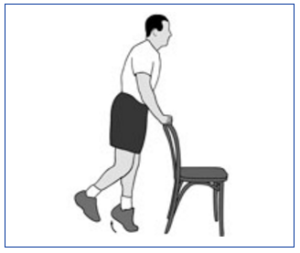
Calf Raises — two (2) sets of ten (10) for six (6) to seven (7) days each week
Main muscles worked: Back of calf downward to heel
Steps
-
Stand with your weight evenly distributed over both feet. Hold onto the back of a chair or a wall for balance.
-
Lift your unaffected foot off of the floor so that all of your weight is placed on your affected foot.
-
Raise the heel of your affected foot as high as you can, then lower.
-
Repeat 10 times.
TIP: Keep your weight centered on the ball of your working foot.
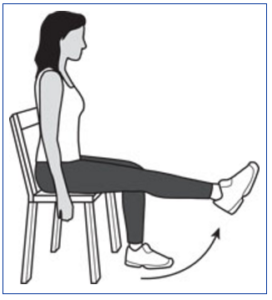
Leg Extensions — three (3) sets of ten (10) for four (4) to five (5) days each week
Main muscles worked: Quadriceps
As the exercise becomes easier to perform, gradually increase the resistance by adding an ankle weight. Begin with a 5 lb. weight and gradually progress to a greater level of resistance, up to a 10 lb. weight.
This exercise can also be performed on a weight machine at a fitness center.
Steps
-
Sit up straight on a chair or bench.
-
Tighten your thigh muscles and slowly straighten and raise your affected leg as high as possible.
-
Squeeze your thigh muscles and hold this position for 5 seconds. Relax and bring your foot to the floor. Repeat.
TIP: Do not swing your leg or use forceful momentum to lift it higher.
Straight-Leg Raises — three (3) sets of ten (10) for four (4) to five (5) days each week
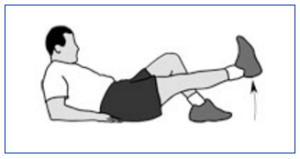
Main muscles worked: Quadriceps
As the exercise becomes easier to perform, gradually increase the resistance by adding an ankle weight. Begin with a 5 lb. weight and gradually progress to a greater level of resistance, up to a 10 lb. weight.
This exercise can also be performed on a weight machine at a fitness center.
Steps
-
Lie on the floor with your elbows directly under your shoulders to support your upper body.
-
Keep your affected leg straight and bend your other leg so that your foot is flat on the floor.
-
Tighten the thigh muscle of your affected leg and slowly raise it 6 to 10 inches off the floor.
-
Hold this position for 5 seconds and then relax and bring your leg to the floor. Repeat.
TIP: Do not tense up in your neck and shoulders.
Straight-Leg Raises (Prone) — three (3) sets of ten (10) for four (4) to five (5) days each week
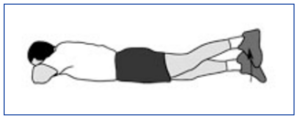
Main muscles worked: Hamstrings, gluteus
As the exercise becomes easier to perform, gradually increase the resistance by adding an ankle weight. Begin with a 5 lb. weight and gradually progress to a greater level of resistance, up to a 10 lb. weight.
This exercise can also be performed on a weight machine at a fitness center.
Steps
-
Lie on the floor on your stomach with your legs straight. Rest your head on your arms.
-
Tighten your gluteus and hamstring muscles of the affected leg and raise the leg toward the ceiling as high as you can.
-
Hold this position for 5 seconds.
-
Lower your leg and rest it for 2 seconds. Repeat.
TIP: Keep your pelvic bones on the floor.
Hip Abduction — three (3) sets of twenty (20) for four (4) to five (5) days each week
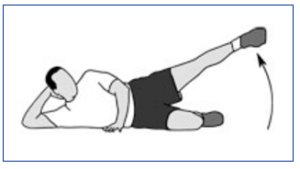
Main muscles worked: Abductors, gluteus
As the exercise becomes easier to perform, gradually increase the resistance by adding an ankle weight. Begin with a 5 lb. weight and gradually progress to a greater level of resistance, up to a 10 lb. weight.
Steps
-
Lie on your side with your injured leg on top and the bottom leg bent to provide support.
-
Straighten your top leg and slowly raise it to 45°, keeping your knee straight, but not locked.
-
Hold this position for 5 seconds.
-
Slowly lower your leg and relax it for 2 seconds. Repeat.
TIP: Do not rotate your leg in an effort to raise it higher.
Hip Adduction — three (3) sets of twenty (20) for four (4) to five (5) days each week
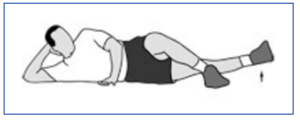
Main muscles worked: Adductors
As the exercise becomes easier to perform, gradually increase the resistance by adding an ankle weight. Begin with a 5 lb. weight and gradually progress to a greater level of resistance, up to a 10 lb. weight.
Steps
-
Lie down on the floor on the side of your injured leg with both legs straight.
-
Cross the uninjured leg in front of the injured leg.
-
Raise the injured leg 6 to 8 inches off the floor.
-
Hold this position for 5 seconds.
-
Lower your leg and rest for 2 seconds. Repeat.
TIP: Place your hand on the floor in front of your stomach for support.
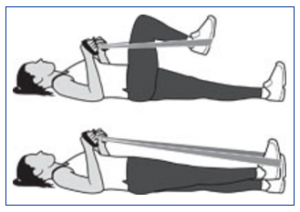
Leg Presses — three (3) sets of ten (10) for four (4) to five (5) days each week
Main muscles worked: Quadriceps, hamstrings
This exercise is best performed using an elastic stretch band of comfortable resistance. As the exercise becomes easier to perform, gradually increase the level of resistance. Do not use ankle weights with this exercise.
This exercise can also be performed on a weight machine at a fitness center.
Steps
-
Place the center of the elastic band at the arch of your foot and hold the ends in each hand. Lie on the floor with your elbows bent.
-
Tighten the thigh muscle of your affected leg and bring your knee toward your chest.
-
Flex your foot and slowly straighten your leg directly in front of you, pushing against the elastic band.
-
Hold this position for 2 seconds. Relax and bring your leg to the floor. Repeat.
TIP: Keep your abdominals tight throughout the exercise.
SOURCE:
Knee Conditioning Program. (October, 2012). American Academy of Orthopedic Surgeons.